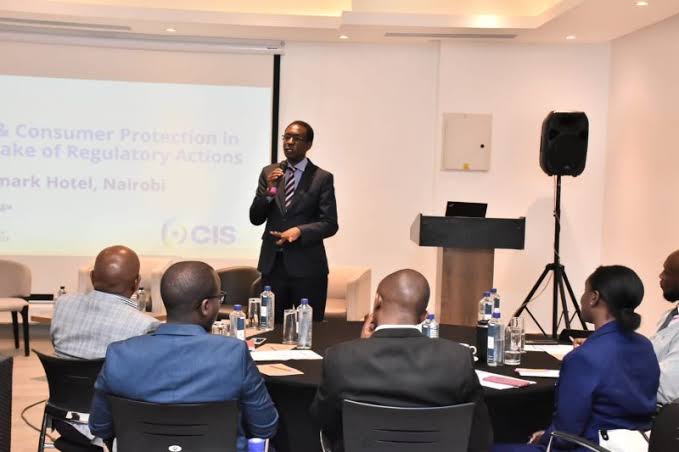
Financial Sector Deepening (FSD) Kenya, Credit Information Sharing Association of Kenya (CIS Kenya) and Creditinfo Credit Refence Bureau Kenya Limited (Creditinfo CRB) have launched the findings a study on Kenya’s credit market landscape.
The study on Kenya’s credit market landscape is based on an analysis of credit records held by Creditinfo CRB.
 The use of Credit Reference Bureau data in this study provides an opportunity to analyse credit data that is aggregated from various sources and segmented according to borrower’s sex, type of loan (digital and non-digital), type of borrower (company and individual), and provider type (bank, MFB, and MFI). The data covers the 5-year period from January 2019 to December 2023.
The use of Credit Reference Bureau data in this study provides an opportunity to analyse credit data that is aggregated from various sources and segmented according to borrower’s sex, type of loan (digital and non-digital), type of borrower (company and individual), and provider type (bank, MFB, and MFI). The data covers the 5-year period from January 2019 to December 2023.
 Summary findings;
Summary findings;
- Kenya’s credit market is dominated by digital loans (in volume terms) provided by banks mostly to male borrowers. Banks continue to dominate the retail lending market, accounting for over 90% of the volume and value of digital and non-digital loans.
- The number of unique borrowers has been on a steady increase on an annual basis, with 7.5 million unique borrowers in 2019 compared to 11.4 million unique borrowers in 2023. This constitutes both individual and non-individual borrowers (companies). On average, there are 6m unique male borrowers and 4.3m female borrowers each year
- In contrast to the increase of unique borrowers, the aggregate value of loans disbursed annually has been on a decline, with KShs 2,067bn issued in 2019 compared to KShs 1,937bn in 2023. Male borrowers accounted for 61.4% of the total number of loans and 71.1% of the total value of loans issued between 2019 to 2023.
- On average, there are 10 million unique borrowers who have at least one digital loan annually compared to 1 million for non-digital loans. Approximately 270 million new digital loans valued at KShs 1,512 billion were issued over the five-year period compared to 7.8 million non-digital loans valued at KShs 8,282 billion over the same period.
 There is, however, an observed decline in the average value of nondigital loans, from an average of KShs 8,353 in 2019 to an average of KShs 4,555 in 2023, a 45% decline.
There is, however, an observed decline in the average value of nondigital loans, from an average of KShs 8,353 in 2019 to an average of KShs 4,555 in 2023, a 45% decline.
- The number of new negative listings declined by more than half between 2019 and 2023. Whilst this can be attributed to changes in the regulatory framework on the treatment of negative listings, there is a marked decline between 2019 and 2020 which was before the regulatory changes. In 2023, 933,551 individual borrowers were negatively listed with Creditinfo CRB compared to 2,204,591 individuals in 2019.
- Female borrowers have better repayment histories compared to men, accounting for an approximately of 36% of the new negative listings over five-year period, compared to 64% for men.
- Most borrowers who have a negative record have an outstanding loan balance of between KShs 1,001 to KShs 5,000. The data further indicates that a higher proportion of borrowers initially listed as having repayment difficulties with their loans (negative record) managed to fully repay them off after seven months and within one year.
- 69% of borrowers that previously had a negative record were subsequently issued with a new loan. This is contrary to the public’s perception that the CIS mechanism is a blacklisting tool and that a negative listing automatically precludes a borrower from accessing future loans.

- “The development of Kenya’s credit market is at the core of FSD Kenya’s work and strategy.
While many of the building blocks that underpin an efficient and effective retail market are in place, available evidence points that the provision of appropriate and affordable credit remains a challenge.
MSMEs and women continue to be underserved.
FSD Kenya’s work in credit market is aimed at working with various partners to address the factors that constrain the flow of productive credit to where it is needed the most.
Part of this includes creating the knowledge and evidence base through research and analysis to inform the direction of market development and policy interventions.
This study is part of those efforts.
The expectation is that the study will provide the basis for engagement with various stakeholders on the development of Kenya’s credit market, long-term policy implications, and the functioning of Kenya’s Credit Information Sharing mechanism.”, said Francis Gwer, FSD Kenya’s Senior policy specialist.
“The Credit Information Sharing (CIS) mechanism has significantly advanced since its inception in Kenya.
The transition from negative-only reporting to the bureau to comprehensive full-file reporting to the bureau marked a pivotal moment, fostering innovation and financial inclusion.
Data gathered throughout this evolution has proven invaluable for market growth and innovation.
Further advancements, such as incorporating all credit sectors and enabling real-time reporting, have the potential to elevate the CIS mechanism to new heights.”, said Kamau Kunyiha, Regional Manager, Creditinfo CRB






